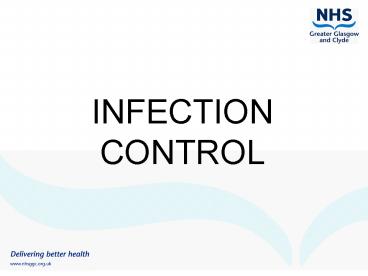INFECTION CONTROL - PowerPoint PPT Presentation
1 / 25
Title:
INFECTION CONTROL
Description:
INFECTION CONTROL Patients are vulnerable to infection WHERE CAN MICRO-ORGANISMS BE FOUND ? Environment People Equipment Food WHAT DO MICRO-ORGANISMS NEED TO GROW? – PowerPoint PPT presentation
Number of Views:165
Avg rating:3.0/5.0
Title: INFECTION CONTROL
1
- INFECTION CONTROL
2
Why is Infection Control Important?
3
Hospitals should do the sick no harm. Florence
Nightingale (1859)
4
Patients are vulnerable to infection
5
- WHERE CAN MICRO-ORGANISMS BE FOUND ?
- Environment
- People
- Equipment
- Food
- WHAT DO MICRO-ORGANISMS NEED TO GROW?
- Warmth
- Moisture
- Food source
- Time
6
HOW DO THEY SPREAD?
- Hands
- Through the air
- Via equipment e.g. Commodes
- Puncture of the skin
- Food
- An infected person
- Droplets
- Contact
- Skin scales
7
- Standard precautions are the minimal level of
infection control precautions that apply to all
patients at all times in all situations.
8
- Who is responsible for implementing
- Standard Precautions?
9
- We all are.
- All NHSGGC employees must follow the
requirements of the Standard Precautions Policy
See your ward Infection Control Manual for
information.
10
PPE
There are 10 elements to Standard Precautions
Isolating infectious patients
Spillages
Cough Etiquette
11
Hand Hygiene
- The simplest and most effective method of
preventing the spread of infection
12
Hand Hygiene
- Simple and effective
- Proven to reduce the risk of acquiring HAI
- Use of alcohol gels
- Performed between each patient intervention
- Ensure technique is good
13
Palm to palm fingers interlaced.
Right palm over left dorsum and left palm over
right dorsum.
Wet hands, apply soap. Palm to palm.
Rotational rubbing, backwards and forwards with
clasped fingers of right hand in left palm and
vice versa.
Rotational rubbing of right thumb clasped in left
palm and vice versa.
Backs of fingers to opposing palms with fingers
interlocked.
Remember to wash past your wrists
14
(No Transcript)
15
Alcohol Hand Gel
- Used as a compliment to handwashing not a
replacement - Good for rapid disinfection of skin
- Can only be used on physically clean hands
- Suitable for use on ward rounds between patients.
- Should only be used up to 5 times then wash hands
with soap and water - Placed at every bed space within NHSGGC
16
PERSONAL PROTECTIVE EQUIPMENT (PPE)
- Gloves
- Aprons
- Eye protection
- Face shields
- Masks
17
Isolation
- Protective
- Vulnerable patients, with poor immune systems.
- Patients who may be receiving chemotherapy
- Stop these patients catching an infection
- Source
- Patients identified as carrying bugs that could
cause other patients to become ill if it was
passed onto them.
18
Methicillin Resistant Staphylococcus Aureus (MRSA)
- What is MRSA?
- What are the predisposing risk factors?
- What is colonised, What is infected?
- How is MRSA transmitted
19
MRSA screening
- Who should be screened
- When should they be screened
- What samples should be taken
- What treatment should be given
- What about isolation
20
Clostridium difficile
- Symptoms
- Watery, foul smelling stools.
- Abdominal pain.
- Pyrexia (high temperature)
- Dehydration.
21
How to prevent spread of Clostridium Difficile
to other patients
- If they have diarrhoea send a sample.
- Isolate them in a side room.
- Use Personal Protective Equipment.
- Encourage the patient to wash their hands after
using the toilet. - Clean the commode thoroughly after every use with
Actichlor Plus.
22
OUTBREAKS
23
OUTBREAKS
- What is an outbreak
- When should infection control be notified
- What information is required
- Can patients be discharged/transferred
- Can patients attend for examinations e.g. x-ray
- Enhanced cleaning
- Outbreak is over, what now?
24
BRISTOL STOOL CHART
Long Transit e.g 100 hours
Type 1 Separate hard lumps, like nuts hard to pass
Type 2 Sausage shaped but lumpy
Type 3 Like sausage but with cracks on the surface
Type 4 Like sausage or snake, smooth and soft
Type 5 Soft blobs with clear cut edges (passed easily)
Type 6 Fluffy pieces with ragged edges, a mushy stool
Type 7 Watery, no solid pieces
Types 1-5 do not send specimens to microbiology.
Types 6 and 7 send specimens to microbiology
Short transit e.g 10 hours
25
Prevention and Control of Infection Team
- There are Prevention and Control of Infection
Teams available for specialist Infection Control
advice within NHSGGC - Contact details of local Infection Control Teams
(ICT) can be found within NHSGGC Prevention and
Control of Infection Manual, via your local
switchboard or website www.nhsggc.org.uk/infectio
ncontrol































